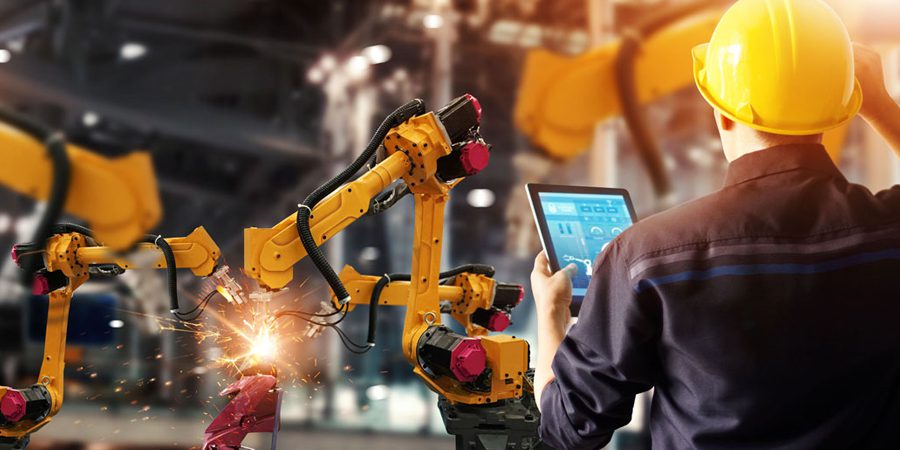Manufacturing Builds a Better Tomorrow Today

With a long history in the industry, Cincinnati’s manufacturing legacy is just getting started.
Manufacturing—it’s oft-cited by economists, politicians and industry leaders as essential, and for good reason. Manufacturing is a core pillar in our modern economy, with employment strength that has long been seen as providing opportunity to create stable, financially secure lives in the middle class. Manufacturing is the connection point between idea and product, making things out of concepts and we will always need those physical items at the core of everyday life to be optimized, fashioned and assembled.
For these reasons and more, manufacturing is here to stay.
Chief among manufacturing’s powerful traits is the sheer breadth of the industry’s reach. Manufacturing is central to the automotive subsector, sure, but it’s also the stage where the rubber hits the road for technology, aerospace, chemical production and even food, flavorings, and beverages. Manufacturing trains a workforce with skills that are transferable across industry subsectors; likewise, technological advancement in the manufacturing industry has enormous impact as it is adapted across various applications.
Here in the Cincinnati MSA, this adaptability of workforce skill and technological advancement is on full display, with a manufacturing economy that is resilient, diverse and powerful.
A River City Built on Building
Labor jobs have been the backbone of Cincinnati’s local economy for centuries—just head to Union Terminal to take in the Winold Reiss mosaic mural, with its depiction of early 1900-era workers, for historical proof. In fact, the earliest days of Cincinnati’s economy—going back to 1811—were supported by shipbuilders, when riverboats first appeared along the city’s riverfront. Following the riverboat boom, the manufacture of machine tools grew to become big business in Cincinnati, home to Cincinnati Machine Milling Co., which grew into the country’s largest machine-manufacturing enterprise by the 1930s. For a while the city also led the world in the production of horse-drawn vehicles, acting as home to a handful of manufacturers (such as Anchor Buggy and Carriage Company) of carriages, wagons and buggies.
Even Henry Ford—who eventually opened a Model-T production facility in what’s now the Cincinnati Children’s Hospital Walnut Hills office building—looked to the city’s pork production lines for inspiration in his ground-breaking approach to manufacturing.
Same as It Ever Was
Today, Cincinnati’s legacy as a manufacturing hotspot continues apace, with regional growth in manufacturing that has more than doubled the national average during the last five years—with projections to increase by 3% over the next half-decade. And this stellar growth is due to the same factors that have powered the Queen City’s economy since its inception, led by a robust labor force and opportune logistical positioning.
Cincinnati’s major manufacturing firms fall across a range of industries that include automotive, aerospace, chemical manufacturing, food manufacturing (including flavoring and beverages), robotics and personal protective equipment. In all, the region is home to 798 manufacturing business locations and a gross regional product (GRP) of $6.3B. Just a few of the many big players in local manufacturing are GE Aerospace, Bosch, Molson Coors, Kroger, Ford, Mazak, Shellback Semiconductor Technology.
The Cincinnati MSA is home to more than 31K manufacturing industry workers, which is more than a 32% higher concentration in manufacturing jobs than the national average. This employment snapshot follows a 3% growth in jobs over the five-year period between 2019 and 2023. The most popular job in our area is general and operations manager (almost 28k in 2023), followed by laborers and freight, stock and material movers (27,348). There are some 14,263 area workers in the “miscellaneous assemblers and fabricators” category, 12,686 sales reps for wholesale and manufacturing and 8,532 shipping, receiving and inventory clerks.
Locally, industrial production managers can expect the highest wage, with a median hourly wage of $48.96. And general and operations manager positions have seen the highest percentage of growth at a whopping 71%.
With the manufacturing industry on such a rapid pace of local growth—for example, Fisker and Lordstown Motors will start manufacturing the new Fisker PEAR all-electric vehicles in Ohio beginning next year—it’s safe to say that Cincinnati’s manufacturing legacy is a story still being told.
Powerful Workforce
The heart of Cincinnati is its people, and at the center of the MSA’s manufacturing success is a robust and capable workforce. Our region boasts 32% more manufacturing workers than the national average, and we have the training capabilities and attractive living conditions that ensure a strong talent population well into the future.
Local institutions have stepped up with programs to educate tomorrow’s workers on the skills to succeed in manufacturing. Universities like University of Cincinnati, Northern Kentucky University and Xavier University—not to mention community colleges (Cincinnati State, Sinclair) and career technical centers (Butler Tech, Great Oaks)—are all home to a combined 87 programs aimed at future-ready careers in fields that support our manufacturing industry. And our strong higher education ecosystem is actively training workers in tomorrow’s biggest manufacturing fields, such as robotics, with 11,131 graduates in STEM education in 2023—a 13.8% increase that occurred over the preceding 5-year period.
This locally trained workforce is incentivized to stay here in the region, because Cincinnati is just pleasant—seriously, the local average high is 64.8 degrees F with an average annual low of just 44.5 degrees F. Cincinnati is located outside major U.S. earthquake, hurricane, volcano and tsunami zones, and rarely sees winter storms, tornadoes and flooding. And when people need a break from this ideal seasonal weather, they can head to CVG (the #6 best airport in the whole world serving 5-10 million passengers) and travel to 66% of the country in 90 minutes or less. Globe-hoppers also can enjoy the airport’s convenient direct international flights.
Cincinnati is also a famously affordable place to live and work, too, offering a significant benefit to any business considering moving or expanding into Cincinnati, where it really is possible to gain payroll savings while still providing employees with income to enjoy a higher quality of life in a truly great place.
Manufacturing was a key building block of Cincinnati’s economy, and the industry is a cornerstone the city’s future prosperity, too.
About REDI Cincinnati
The Regional Economic Development Initiative (REDI) Cincinnati is the first point-of-contact for companies locating or growing in the 15-county region at the heart of southwest Ohio, northern Kentucky, and southeast Indiana. REDI Cincinnati is supported by top business leaders and community partners and staffed by a team of economic development experts who are uniting the Cincinnati region to compete globally.
The future is bright, and we’re building it, right now. Join us at REDICincinnati.com.
